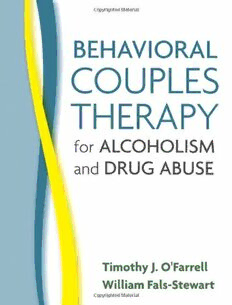
Behavioral Couples Therapy for Alcoholism and Drug Abuse PDF
Preview Behavioral Couples Therapy for Alcoholism and Drug Abuse
Behavioral Couples Therapy for Alcoholism and Drug Abuse This page intentionally left blank BEHAVIORAL COUPLES THERAPY for ALCOHOLISM and DRUG ABUSE Timothy J. O’Farrell William Fals-Stewart THE GUILFORD PRESS New York London ©2006TheGuilfordPress ADivisionofGuilfordPublications,Inc. 72SpringStreet,NewYork,NY10012 www.guilford.com Allrightsreserved Exceptasindicated,nopartofthisbookmaybereproduced,translated,storedinaretrievalsystem, ortransmitted,inanyformorbyanymeans,electronic,mechanical,photocopying,microfilming, recording,orotherwise,withoutwrittenpermissionfromthePublisher. PrintedintheUnitedStatesofAmerica Thisbookisprintedonacid-freepaper. Lastdigitisprintnumber: 9 8 7 6 5 4 3 2 1 LIMITEDPHOTOCOPYLICENSE Thesematerialsareintendedforuseonlybyqualifiedmentalhealthprofessionals. ThePublishergrantstoindividualpurchasersofthisbooknonassignablepermissiontoreproduce the checklists in Appendix A, the posters in Appendix B, and the forms in Appendix C. This licenseislimitedtoyou,theindividualpurchaser,forusewithyourownclientsandpatients.It doesnotextendtoadditionalcliniciansorpracticesettings,nordoespurchasebyaninstitution constitute a site license. This license does not grant the right to reproduce these materials for resale,redistribution,oranyotherpurposes(includingbutnotlimitedtobooks,pamphlets,arti- cles,video-oraudiotapes,andhandoutsorslidesforlecturesorworkshops).Permissiontorepro- duce these materials for these and any other purposes must be obtained in writing from the PermissionsDepartmentofGuilfordPublications. LibraryofCongressCataloging-in-PublicationData O’Farrell,TimothyJ. Behavioralcouplestherapyforalcoholismanddrugabuse/byTimothyJ.O’Farrell,William Fals-Stewart. p.cm. Includesbibliographicalreferencesandindex. ISBN-10:1-59385-324-6 ISBN-13:978-1-59385-324-2(pbk.) 1. Alcoholism—Treatment. 2. Maritalpsychotherapy. 3. Drugabuse—Treatment. 4. Marital psychotherapy. I. Fals-Stewart,William. II. Title. RC565.O342006 616.86′106—dc22 2006006047 ScreenBeansclipartimagesinFigures3.2,6.1,6.5,and6.6;inPostersB.4,B.11,B.15,andB.17; andinFormC.10areusedwithpermissionfromABitBetterCorporation.ScreenBeansisaregis- teredtrademarkofABitBetterCorporation. To Jayne and Colin —T. J. O. To my family—Leslie, Emily, and Will —W. F. S. About the Authors TimothyJ.O’Farrell,PhD,ABPP,isProfessorofPsychologyintheDepartmentofPsychiatry atHarvardMedicalSchool,andhedirectstheFamiliesandAddictionProgramandtheCoun- selingforAlcoholics’Marriages(CALM)ProjectattheVABostonHealthcareSystem.Hisclin- icalandresearchinterestsfocusprimarilyoncoupleandfamilytherapyinalcoholismanddrug abusetreatmentandvariousaspectsofsubstanceabusers’familyrelationships,includingpart- ner violence, child functioning, and sexual adjustment. Dr. O’Farrell’s books include Alcohol andSexuality(1983),TreatingAlcoholProblems:MaritalandFamilyInterventions(1993),and Substance Abuse Program Accreditation Guide (1997). WilliamFals-Stewart,PhD,isaclinicalpsychologist,aprincipalscientistatRTIInternational in Research Triangle Park, North Carolina, and the Director of the Addiction and Family Research Group at RTI. His clinical and research interests include the effects of substance abuse on the family, partner- and family-involved treatments for alcoholism and drug abuse, and psychological assessment. vi Preface A 1974 report from the National Institute on Alcohol Abuse and Alcoholism (NIAAA) to the U.S.Congresscalledcoupleandfamilytherapy“oneofthemostoutstandingcurrentadvances in the area of psychotherapy of alcoholism.”1 Case reports and uncontrolled treatment studies that presented favorable results were the basis for this enthusiastic appraisal. NIAAA recom- mended that controlled outcome studies should be conducted to evaluate these promising treatmentmethods.ThisreportcameinthebeginningyearsofNIAAAandtheNationalInsti- tute on Drug Abuse (NIDA), which were founded on the hope that science would improve treatment outcomes for patients with alcoholism and substance abuse. Now over 30 years later, considerable research has confirmed the early enthusiasm for couple and family therapy, and family involvement in substance abuse treatment is generally accepted. However, evidence-based couple and family therapy methods are not widely prac- ticed. Behavioral couples therapy (BCT), the subject of this book, is the most effective couple and family therapy method with by far the largest number of studies supporting its effective- nessintreatingsubstanceabuseamongadults.2StudiesshowthatBCTproducesgreaterabsti- nenceandbetterrelationshipfunctioningthantypicalindividual-basedtreatmentandreduces socialcosts,domesticviolence,andemotionalproblemsofthecouple’schildren.BCTiscited asanempiricallysupportedmethodbyvirtuallyallrecentreviewsofresearchonpsychosocial treatments for alcoholism and drug abuse and by statements from both NIAAA and NIDA. Thus BCT is well known among substance abuse researchers. Unfortunately, BCT is virtually unknown and unused by practitioners.3 SowhyistheresuchahugegapbetweenresearchandpracticewhereBCTisconcerned? Wehavebeenaskingourselvesthisquestionmoreandmoreinrecentyearsaswecompleted studyafterstudydemonstratingtheefficacyofBCTbutdidnotseeanyincreaseduseofBCT intreatmentcentersaroundthecountry.WestartedourfirststudyofBCT4in1977andthere wasalotaboutBCTinscientificjournalarticlesovermanyyears,buttherewasnocomprehen- siveguidebookandtreatmentmanualavailableonBCT.Westartedtorealizethatwemaybe partlytoblamefortheresearch–practicegapinBCT.Weconcentratedsomuchondoingstud- ies of BCT that we were not making available the tools counselors need to implement BCT. Once we realized we were part of the problem, we set out to create this book. vii viii Preface In this volume we offer a comprehensive guidebook on BCT for alcoholism and drug abuse.ItincludesanextensivepractitionerguidetoBCTwithmanycaseexamplesandconsid- eration of problem cases and challenging clinical situations, plus a session-by-session BCT treatmentmanual.Itshowsyouhow,andprovidesformsandmaterialsneeded,toutilizeeach part of BCT. You will learn how to (1) engage couples to take part in BCT, (2) support absti- nence with a “recovery contract” that involves both members of the couple in a daily ritual to rewardabstinence,(3)improvetherelationshipwithtechniquesforincreasingpositiveactivi- ties and improving communication, and (4) plan for continuing recovery to prevent or mini- mize relapse. Each of these efforts helps BCT achieve its purpose: to build support for abstinence and to improve relationship functioning among married or cohabiting individuals seeking help for alcoholism or drug abuse. Chapter 1 introduces the background, concepts, and procedures of BCT and provides a detailed preview of the book’s contents. Chapters 2–11 describe how to implement the four parts of the BCT program, including recent developments combining BCT with parent train- ing,partnerviolenceprevention,andHIVriskreduction.Theclosingchapterconsiderspracti- calissuesinimplementingBCTinday-to-daypractice,suchasgettingadministrative“buy-in” tostartaBCTprogramandchoosingbetweenbriefversusmoreextendedandone-couple-at-a- time versus couples group BCT formats. Appendices include a session-by-session BCT treat- ment manual and reproducible checklists, forms, and client education posters that you may copy and use with your clients. Thisbookisintendedtogiveyou,thepractitioner,theclinicaltoolsyouneedtouseBCT inyourworkwithsubstance-abusingindividualsandtheirspousesordomesticpartners.Incor- porating BCT into your practice should be relatively easy because BCT is readily compatible with 12-step approaches and other types of counseling. The ultimate value of this book will comefromyourownattemptstoapplythemethodspresentedhereinyourday-to-dayworkto help substance-abusing patients and their families. NOTES 1. Keller (1974, p. 116). 2. Epstein and McCrady (1998). 3. Fals-Stewart and Birchler (2001). 4. O’Farrell and Cutter (1977a, 1977b). Acknowledgments W ethankthemanyindividualswhocontributedtothisbookandtotheworkonwhichitis based. We acknowledge our debt to the pioneers in the field on whose work we built: Alan Hedberg,PeterMiller,NathanAzrin,andBarbaraMcCradyfortheirearlyworkonBCTwith alcoholism;andRobertLiberman,JohnGottman,andRichardStuartfortheirworkonBCTfor marital conflict without substance abuse. A special note of appreciation goes to Gary Birchler who trained Bill Fals-Stewart in BCT, helped Bill launch the first study of BCT with drug abuse,introducedustoeachother,andjoinedtogetherinmanycollaborativestudiesofBCT. Inaddition,wethankMichaelFeehanandMichelleKelleyforpushingustolookattheeffects ofBCTonchildren,whichhasnowbecomeaveryimportantpartofthisprogrammaticlineof research. TimO’FarrellthanksthefollowingindividualswhocontributedtohisworkonBCT:Jane Alter,JudithBayog,AlfredoChan,KeithChoquette,KevinClancy,HenryCutter,MarieFair- banks, David Goodenough, Terence Keane, Fay Larkin, Steve Maisto, Robert McCarley, Jim McKay,PatriceMuchowski,ChristopherMurphy,MarieMurphy,LeslieReid,RobRotunda, and Dennis Upper. Bill Fals-Stewart thanks the following individuals who contributed to his work on BCT: Elizabeth Barkley, David Beniamino, Cyndy Birke, Deborah Birke, Margaret Birke, Beth Bossler-Kogut, Cindy Byrne, Deborah Evans, James Golden, Sally Hayes, Mae Hodge, Todd Kashdan,KeithKlostermann,TimothyLogsdon,JillMurray,EllenRoche,LindaWalters,and Jamie Winters. We gratefully acknowledge funding for our research on BCT that is the basis of this book from the National Institute on Alcohol Abuse and Alcoholism, the National Institute on Drug Abuse, the Department of Veterans Affairs, the Alpha Foundation, the Harry Frank Guggenheim Foundation, and the Smithers Foundation. We appreciate the outstanding work onthisbookbyTheGuilfordPress,withspecialthankstoJimNageotte,whoencouragedusto write this book and shepherded us through each step of the process; Barbara Watkins for her extremelyhelpfuleditingofourfirstdraft;andLauraSpechtPatchkofskyforherpatienceand skillinproduction.Finally,wethankourfamiliesfortheirlove,support,andwillingnesstoput up with our hectic work schedules. ix
